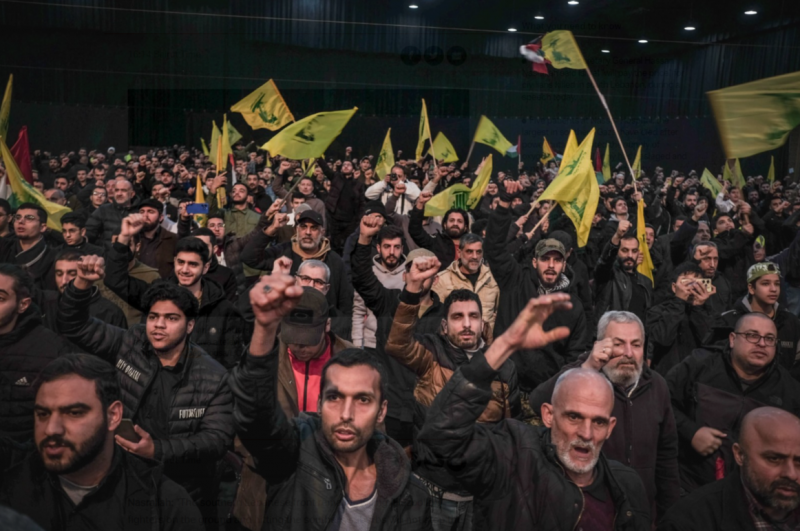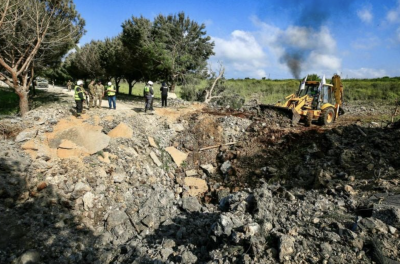
A crowd of Hezbollah supporters cheer while listening to the party's secretary-general, Hassan Nasrallah, give a televised speech on Feb. 16, 2024, in a southern suburb of Beirut. (Credit: João Sousa/L'Orient Today)
BEIRUT — A Hezbollah commander, an executive officer, a fighter, and a civilian were killed in southern Lebanon on Tuesday in two separate Israeli air strikes that targeted cars in the villages of Ain Baal, southeast of Sour, and Shehabieh, in Sour district. Both villages sit outside the 10-kilometer strip along the southern border within which the majority of Israeli strikes occur.
Ain Baal was the first of the two strikes, in mid-afternoon, and was claimed by the Israeli army shortly after. The military radio announced it had "eliminated Ismail Youssef Baz, the commander of Hezbollah's coastal sector.”
A source close to Hezbollah told AFP that the victim was a “commander for the Naqoura region,” in southern Lebanon. Hezbollah announced Baz’s death, describing him as a party member from Shehabieh. The party will rarely announce a casualty’s rank. A security source confirmed with our correspondent that Baz was killed in the Ain Baal car strike.
The Israeli attack on Ain Baal also wounded two civilians who were within the vicinity of the car when it was struck. One of them, Hussein Kerchat, later succumbed to his wounds.
Paramedics from al-Risala Scouts, the medical association affiliated with the Amal Movement, responded to the Ain Baal strike and transferred the victims to local hospitals.
Israeli raid kills two in Shehabieh
Israeli drones struck two cars simultaneously on the road in Shehabieh, in Sour district, later in the afternoon on Tuesday.
Paramedics were dispatched to the site of the strike but were prevented from carrying out their rescue operations by the huge fires that had engulfed both cars and Israeli drones that hovered overhead, raising fears of a second strike. More than a dozen paramedics have been killed by Israeli strikes since fighting began on Oct. 8.
Eventually, it was determined that two people had been killed in the strike, according to a medical source, who also reported injuries. Both of the casualties were members of Hezbollah, our correspondent in the region reported. One was an executive official and the other was a fighter.
In two separate communiques, Hezbollah announced the deaths of Mohammad Hussein Moustapha Shehouri, from the village of Shehabieh, and Mahmoud Ibrahim Fadlallah, from the village of Ainata.
Hezbollah attacks
After a calm morning and early afternoon, cross-border attacks quickly escalated, leading to a nonstop late afternoon and early evening.
Hezbollah claimed responsibility for several attacks against Israel. At 2:25 p.m., it launched a drone attack targeting a "missile defense system" in the village of Beit Hillel in northern Israel, hitting Iron Dome platforms and — according to the party statement — causing casualties, dead and wounded. Earlier in the afternoon, Haaretz reported that two drones exploded in northern Israel, without sounding any alarms, and wounded three people.
Hezbollah announced that it targeted Israeli barracks in the disputed Shebaa Farms and a military site in the Kfar Shuba hills during the afternoon, and in the early evening, it targeted an Israeli army division in the northern Israeli city of Kiryat Shmona and “the headquarters of the Israeli army's 146th division in Jaatoun.”
Around the same time as these last two attacks, Haaretz reported a total of 14 rockets fired from southern Lebanon falling in northern Israel. Citing the Israeli army, Haaretz said 10 rockets launched at Mount Meron fell in open fields, without causing any casualties. About half an hour later, the outlet reported that four rockets fell in the city of Kiryat Shmona, causing light property and infrastructure damage, citing the municipality.
The Iron Dome defense system’s radar is designed to evaluate whether incoming rockets are likely to hit civilian areas and only launch interceptor missiles if it determines this to be the case. If a rocket is likely to land in open areas, the defense system does not fire.
The Israeli army’s defense systems were heavily deployed over the weekend, fending off over 300 missiles and drones launched from Iran in retaliation for an Israeli strike on the Iranian embassy in Damascus on April 1.
